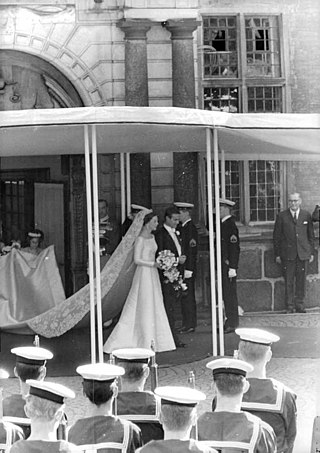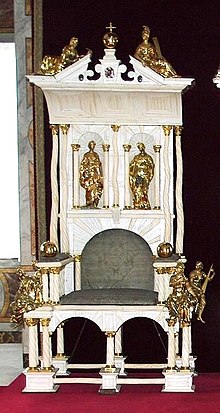
Prince Henrik of Denmark was the husband of Margrethe II of Denmark. He served as her royal consort from Margrethe's accession on 14 January 1972 until his death in 2018.

Frederik IX was King of Denmark from 1947 to 1972.

Princess Benedikte of Denmark, Princess of Sayn-Wittgenstein-Berleburg is a member of the Danish royal family. She is the second daughter and child of King Frederik IX and Queen Ingrid of Denmark. She is the younger sister of Queen Margrethe II of Denmark, and therefore the aunt of Margrethe's son, the current King of Denmark, Frederik X. She is also an older sister of Queen Anne-Marie of Greece.

The Danish royal family is the dynastic family of the monarch of Denmark. While some members of the Danish royal family hold the title of Prince(ss) of Denmark, descendants of Margrethe II additionally bear the title Count(ess) of Monpezat. Children of the monarch are accorded the style of His/Her Royal Highness. The King and Queen are styled Majesty.

Christian, Crown Prince of Denmark, Count of Monpezat, is the heir apparent to the Danish throne. He is the eldest child of King Frederik X and Queen Mary. He was born during the reign of his paternal grandmother, Queen Margrethe II. He became Crown Prince of Denmark following his grandmother's abdication and his father's subsequent ascension to the Danish throne on 14 January 2024.

Princess Nathalie of Sayn-Wittgenstein-Berleburg is a Danish equestrian, an Olympian, and the daughter of Princess Benedikte of Denmark and Prince Richard of Sayn-Wittgenstein-Berleburg. She is the niece of Queen Margrethe II of Denmark and King Constantine II of Greece. Her first cousin is King Frederik X of Denmark.

Richard, 6th Prince of Sayn-Wittgenstein-Berleburg was the head of the House of Sayn-Wittgenstein-Berleburg and husband of Princess Benedikte of Denmark.
Princess Alexandra of Sayn-Wittgenstein-Berleburg, Countess Ahlefeldt-Laurvig-Bille, is the first daughter and second of three children of Prince Richard of Sayn-Wittgenstein-Berleburg and Princess Benedikte of Denmark. Under the succession rules set by King Frederik IX, since Princess Benedikte and her children, including Princess Alexandra, have not taken up permanent residence in Denmark, they have effectively waived their place in the line of succession to the Danish throne. Since 19 May 1998, Alexandra has been a Danish citizen.

Gustav, 7th Prince of Sayn-Wittgenstein-Berleburg, is the eldest child and only son of Princess Benedikte of Denmark and Richard, 6th Prince of Sayn-Wittgenstein-Berleburg.

Princess Isabella of Denmark, Countess of Monpezat, is a member of the Danish royal family. She is the second child and elder daughter of King Frederik X and Queen Mary.

Count Ingolf of Rosenborg is a Danish count and former prince. Born Prince Ingolf of Denmark, he appeared likely to some day become king until the constitution was changed in 1953 to allow females to inherit the crown, placing his branch of the dynasty behind that of his first cousin Princess Margrethe and her two younger sisters. He later gave up his princely rank and his rights to the throne in order to marry a commoner.
Count Christian of Rosenborg was a member of the Danish royal family. Born Prince Christian of Denmark, from 1947 he was third in the line of line of succession until the constitution was changed in 1953 to allow females to inherit the crown, placing his branch of the dynasty behind that of his cousin Margrethe and her two younger sisters. He later gave up his princely rank and his rights to the throne in order to marry a commoner.

The monarchy of Denmark is a constitutional institution and a historic office of the Kingdom of Denmark. The Kingdom includes Denmark proper and the autonomous territories of the Faroe Islands and Greenland. The Kingdom of Denmark was already consolidated in the 8th century, whose rulers are consistently referred to in Frankish sources as "kings". Under the rule of King Gudfred in 804 the Kingdom may have included all the major provinces of medieval Denmark.

The House of Monpezat is a French old bourgeois family from the province of Béarn associated with the Danish royal family by marriage after 1967, when Henri de Laborde de Monpezat wed Princess Margrethe of Denmark, then the heir presumptive of the ruling House of Glücksburg, who was subsequently the Queen of Denmark as Margrethe II. The current Danish monarch, King Frederik X is agnatically a Laborde de Monpezat.

Prince Vincent of Denmark, Count of Monpezat, is a member of the Danish royal family. He is the third child and younger son of King Frederik X and Queen Mary, the sixth grandchild and youngest grandson of Queen Margrethe II and Prince Henrik, and the older twin brother of Princess Josephine.

Countess Athena of Monpezat is a member of the Danish royal family. She is the younger child and only daughter of Prince Joachim and Princess Marie of Denmark. She is the youngest grandchild of Queen Margrethe II and Prince Henrik, and the niece of King Frederik X. Athena is currently ninth in the line of succession to the Danish throne.

The wedding of Frederik, Crown Prince of Denmark, and Mary Donaldson took place on 14 May 2004 in the Copenhagen Cathedral.

Count of Monpezat, or Countess of Monpezat when the holder is female, is a hereditary title of Danish nobility. It was granted on 30 April 2008 by Queen Margrethe II to her two sons, Crown Prince Frederik and Prince Joachim, and their legitimate patrilineal (male-line) descendants of both sexes. The title is derived from the French title of "comte de Laborde de Monpezat", which was used by Frederik and Joachim's father, Prince Henrik.

The wedding of Princess Margrethe of Denmark and Henri de Laborde de Monpezat took place on Saturday, 10 June 1967, at the Holmen Church in Copenhagen, Denmark.















